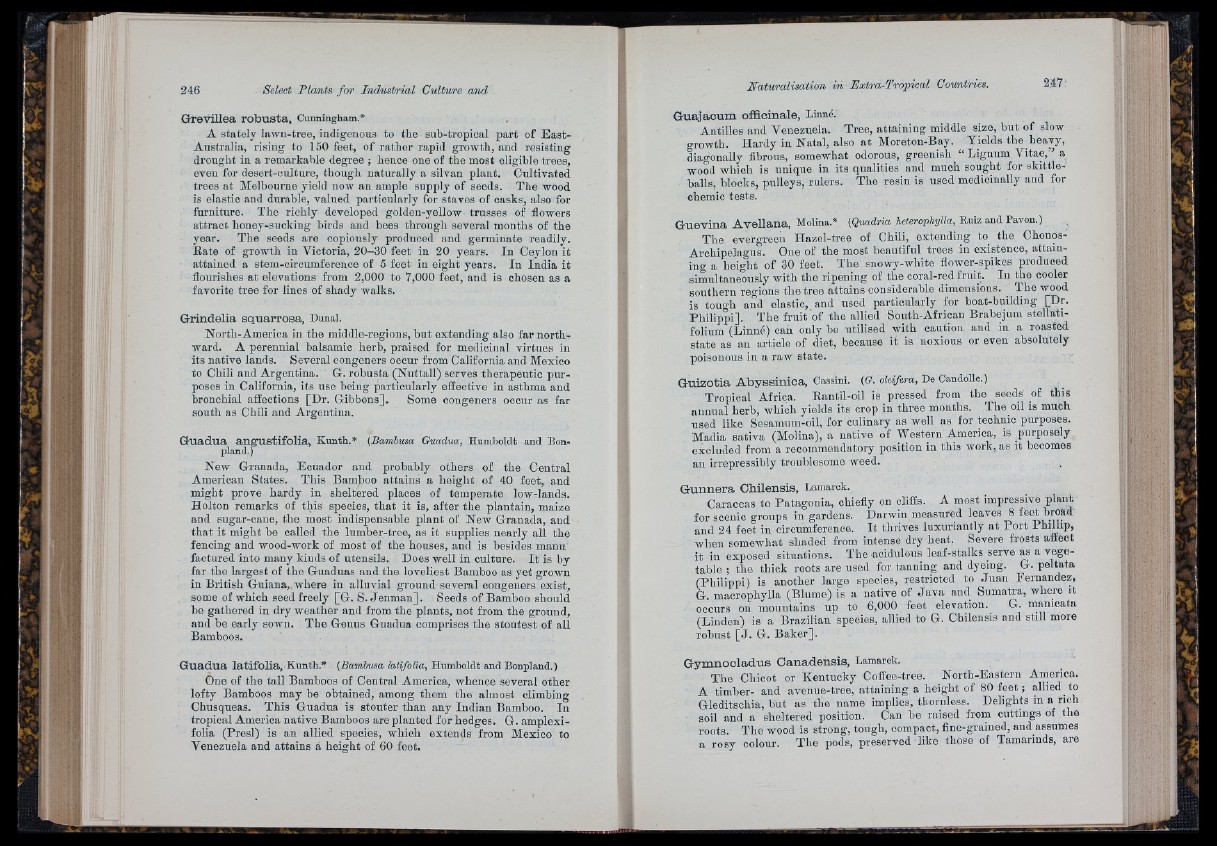
Select Plants fo r Industrial Culture and
GreviUea robusta, Cunningham.*
A stately lawn-tree, indigenous to the sub-tropical part of East-
Australia, rising to 150 feet, of rather rapid growth, and resisting
drought in a remarkable degree ; lience one of the most eligible trees,
even for desert-cnlture, thougli naturally a silvan plant. Cultivated
trees a t Melbourne yield now an ample supply of seeds. The wood
is elastic and durable, valued particularly for staves of casks, also for
furniture. The richly developed golden-yellow trusses of flowers
attract honey-sucking birds and bees through several months of the
year. The seeds are copiously produced and germinate readily.
Rate of growth in Victoria, 20-30 feet in 20 years. In Ceylon it
attained a stem-circumference of 5 feet in eight years. In India it
flourishes at elevations from 2,000 to 7,000 feet, and is chosen as a
favorite tree for lines of shady walks.
Grindelia squarrosa, Dunal.
North-America in the middle-regions, but extending also far northward.
A perennial balsamic herb, praised for medicinal virtues in
its native lands. Several congeners occur from California and Mexico
to Chili and Argentina. G. robusta (Nuttall) serves therapeutic purposes
in California, its use being particularly effective in asthma and
bronchial affections [Dr. Gibbons]. Some congeners occur as far
south as Chili and Argentina.
Guadua angustifolia, Kunth.* (Banibusa Guadua, Humboldt and Bon-
pland.)
New Granada, Ecuador and probably others of the Central
American States. This Bamboo attains a height of 40 feet, and
might prove hardy iu sheltered places of temperate low-lands.
Holton remarks of this species, th a t it is, after the plantain, maize
and sugar-cane, the most indispensable plant of New Granada, and
that it might be called the lumber-tree, as it supplies nearly all the
fencing and wood-work of most of the houses, and is besides manu
factured into many kinds of utensils. Does well in culture. I t is by
far the largest of the Guaduas and the loveliest Bamboo as yet grown
in British Guiana, where in alluvial ground several congeners exist,
some of which seed freely [G. S. Jenman]. Seeds of Bamboo should
be gathered in dry w eather and from the plants, not from the ground,
and be early sown. The Genus Guadna comprises the stoutest of all
Bamboos.
Guadua latifolia, Kunth.* (Bambusa latifolia, Humboldt and Bonpland.)
One of the tall Bamboos of Central America, whence several other
lofty Bamboos may be obtained, among them the almost climbing
Chusqueas. This Guadua is stouter than any Indian Bamboo. In
tropical America native Bamboos are planted for hedges. G. amplexi-
folia (Presl) is an allied species, which extends from Mexico to
Venezuela and attains a height of 60 feet.
Guajacum offloinale, Linné.
Antilles and Venezuela. Tree, attaining middle size, but of slow
growth. Hardy in Natal, also a t Moreton-Bay. Yields the heavy,
diagonally fibrous, somewhat odorous, greenish “ Lignum Vitae,” a
wood which is unique in its qualities and much sought for skittie-
balls, blocks, pulleys, rulers. The resin is used medicinally and for
chemic tests.
Guevina Avellana, Molina.* (Quadria heterophylla, Ruiz and Pavon.)
The evergreen Hazel-tree of Chili, extending to the Chonos-
Archipelagus. One of the most beautiful trees in existence, attaining
a height of 30 feet. The snowy-white flower-spikes produced
simultaneously with the ripening of the coral-red fruit. In the cooler
southern regions the tree attains considerable dimensions. The wood
is tough and elastic, and used particularly for boat-building [Dr.
Philippi]. The fruit of the allied South-African Brabejum stellatifolium
(Linné) can only be utilised with caution and in a roasted
state as an article of diet, because it is noxious or even absolutely
poisonous in a raw state.
Guizotia Abyssinica, Cassini. (G. oUifera, De Candolle.)
Tropical Africa. Rantil-oil is pressed from the seeds of this
annnal herb, which yields its crop in three months. The oil is much
used like Sesamum-oil, for culinary as well as for technic purposes.
Madia sativa (Molina), a native of Western America, is purposely
excluded from a recommendatory position in this work, as it becomes
an irrepressibly troublesome weed.
Gunnera Chilensis, Lamarck.
Caraccas to Patagonia, chiefly on cliffs. A most impressive plant
for scenic groups in gardens. Darwin measured leaves 8 feet broad
and 24 feet in circumference. I t thrives luxuriantly a t P o rt Phillip,
when somewhat shaded from intense dry heat. Severe frosts affect
it in exposed situations. The acidulous leaf-stalks serve as a vegetable
; the thick roots are nsed for tanning and dyeing. G. peltata
(Philippi) is another large species, restricted to Ju a n Fernandez.
G. macrophylla (Blume) is a native of J a v a and Sumatra, where it
occurs on mountains up to 6,000 feet elevation. G. manicata
(Linden) is a Brazilian species, allied to G. Chilensis and still more
robust [ J . G. Baker].
Gymnooladus Canadensis, Lamarck.
The Chicot or Kentucky Coffee-tree. North-Eastern America.
A timber- and avenue-tree, attaining a height of 80 feet ; allied to
Gleditschia, but as the name implies, thornless. Delights in a rich
soil and a sheltered position. Can be raised from cuttings of the
roots. The wood is strong, tough, compact, fine-grained, and assumes
a rosy colour. The pods, preserved like those of Tamarinds, are